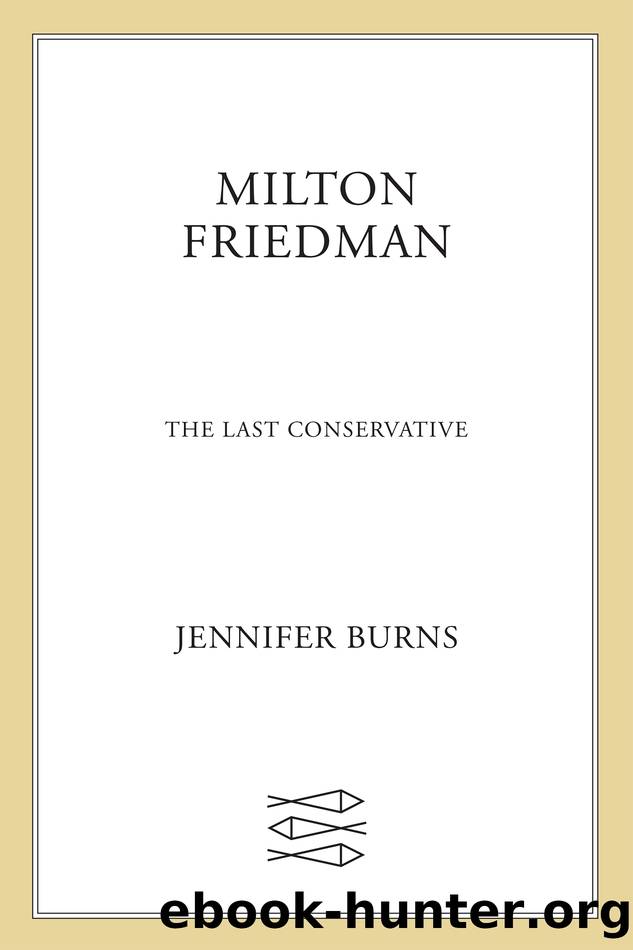Milton Friedman by Jennifer Burns

Author:Jennifer Burns
Language: eng
Format: epub
Publisher: Farrar, Straus and Giroux
* * *
When Burns was finally appointed chair of the Fed in January 1970, Friedman had reason to rejoice. It was a joy to see an old friend rise again and cap his career with such a laurel. Also, Burns had deep exposure to Friedmanâs views on monetary policy, and an almost Godlike ability to put them into action.
The basic structure of the Fed had not changed much from the institution Friedman and Schwartz had so deeply scrutinized. âThe Fedâ was not one central bank but a network of twelve regional banking systems. Atop this national network was the Federal Reserve Board, consisting of seven presidential appointees serving staggered fourteen-year terms. The real action, however, took place at the larger Federal Open Market Committee. Voting members of the FOMC included all members of the board, the president of the New York Fed, and a rotating set of regional Fed presidents. Even if they were not voting, all Fed presidents attended meetings and had their say. If the board was set up to encourage long-term decision-making that transcended the political cycle, the FOMC fostered short-termism by design. During the 1970s, the FOMC met as often as every three weeks, a hangover from the âfine-tuningâ approach to economic policy.
Under the pressure of Wright Patmanâs relentless congressional hearings, the Fed had inched toward transparency. In 1967, attendance at the FOMC and its topics of discussion were finally made public. The inscrutable Record of Policy Actions generated by each meeting, previously released only in one annual batch, now came out after ninety days, accompanied by new Minutes of Action. The Fed also committed to releasing more detailed official minutes and memorandaâafter a five-year lag.26
Power in this complex system was the chairâs for the taking, if he could avoid political snares. The former Fed president Martin called the Federal Reserve âindependent within the government,â a maddeningly opaque charge that left much to interpretation. Martinâs interpretation was that consensus helped maintain independence, and he followed this philosophy to a fault. Martin hated a divided board, and he hated to go against the president or Congress.27
Burns seemed destined to be a defining force at the Fed. If past history was to be a guide, his four-year term might be repeatedly renewed, giving him unusual power. Already, Burns was a Washington veteran. To a degree Martin would have considered unseemly, Burns was close to Nixon and a fixture in the White House. It was also important that Burns was fluent in economics, the language of policy. Friedman certainly believed Burns was uniquely poised to tackle inflation. And the media widely interpreted Burnsâs appointment as a victory for Friedman. With Burns at the helm, âthe Fed will never again be quite so casual about whether or not âmoney matters,ââ wrote The New York Times Magazine in a lengthy profile of Friedman.28
The first signs of Burnsâs tenure were positive, from Friedmanâs perspective. To his delight, Burns seemed to be shifting the Fed toward emphasizing the quantity of money. This meant
Download
This site does not store any files on its server. We only index and link to content provided by other sites. Please contact the content providers to delete copyright contents if any and email us, we'll remove relevant links or contents immediately.
The Art of Coaching Workbook by Elena Aguilar(51000)
Trainspotting by Irvine Welsh(21521)
The Secret History by Donna Tartt(18859)
Twilight of the Idols With the Antichrist and Ecce Homo by Friedrich Nietzsche(18510)
All the Missing Girls by Megan Miranda(15595)
Cat's cradle by Kurt Vonnegut(15190)
Ready Player One by Cline Ernest(14532)
Talking to Strangers by Malcolm Gladwell(13233)
Fangirl by Rainbow Rowell(9106)
The remains of the day by Kazuo Ishiguro(8830)
The Compound Effect by Darren Hardy(8819)
Thirteen Reasons Why by Jay Asher(8800)
Tools of Titans by Timothy Ferriss(8225)
Periodization Training for Sports by Tudor Bompa(8173)
Wonder by R. J. Palacio(8014)
The Lover by Duras Marguerite(7834)
A Court of Wings and Ruin by Sarah J. Maas(7654)
Change Your Questions, Change Your Life by Marilee Adams(7640)
The Complete Stick Figure Physics Tutorials by Allen Sarah(7312)
